2017 MERCEDES-BENZ S-CLASS CABRIOLET traction control
[x] Cancel search: traction controlPage 167 of 521
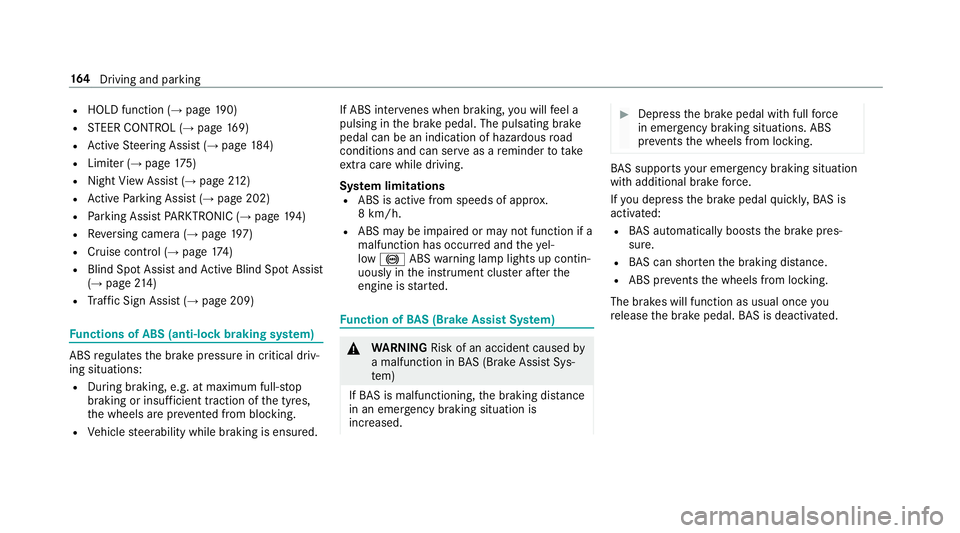
R
HOLD functio n(→ page 190)
R STEER CONTROL (→ page 169)
R ActiveS teering Assis t(→ pag e184)
R Limi ter( →pag e175)
R Nigh tViewA ssist ( →pag e212 )
R ActiveP arking Assis t(→ pag e202)
R Parking Assis tPARKTRONIC (→ page 194)
R Reversing camer a(→pag e197)
R Cruis econtrol (→ page 174)
R Blind Spo tAssis tand ActiveB lind Spo tAssist
( → pag e214 )
R Traf ficS ign Assi st (→pag e209) Fu
nctions of ABS (anti-loc kbraking sy stem) AB
Sr egulates theb rake pressur eincritical driv‐
ing situations:
R During braking, e.g. at maximum full-s top
braking or insuf ficient traction of thet yres,
th ew heels ar epreve nted from blocking.
R Vehicle steerability while braking is ensured. If ABS inter
venes when braking, youw illfeel a
pulsing in theb rake pedal. The pulsating brake
pedal can be an indication of hazardous road
condition sand can ser veas areminder totake
ex trac arew hile driving.
Sy stem limitations
R ABSisa ctivefroms peeds of appr ox.
8k m/h.
R ABS ma ybeimpaire dorm aynotfunction if a
malfunction has occur reda nd they el‐
low ! ABSwarning lam plight supc ontin‐
uousl yinthe instrument clus tera fter the
engine is star ted. Fu
nction of BAS(Brak eAssis tSystem) &
WARNING Risk of an accident caused by
am alfunctio ninBAS (Brak eAssistSys‐
te m)
If BA Sism alfunctioning ,the braking dis tance
in an eme rgency braking situation is
increased. #
Depress theb rake pedal wit hfull force
in emer gency braking situations. ABS
pr eve nts thew heels from locking. BA
Ss uppo rtsy our emer gency braking situation
wit ha dditional brak eforce.
If yo ud epress theb rake pedal quickl y,BA Sis
acti vated:
R BASa utomatically boosts theb rake pres‐
sure.
R BASc an sho rten theb raking dis tance.
R ABS pr events thew heels from locking.
The brakes will function as usual oncey ou
re lease theb rake pedal. BASisd eactivated. 16 4
Driving and pa rking
Page 168 of 521
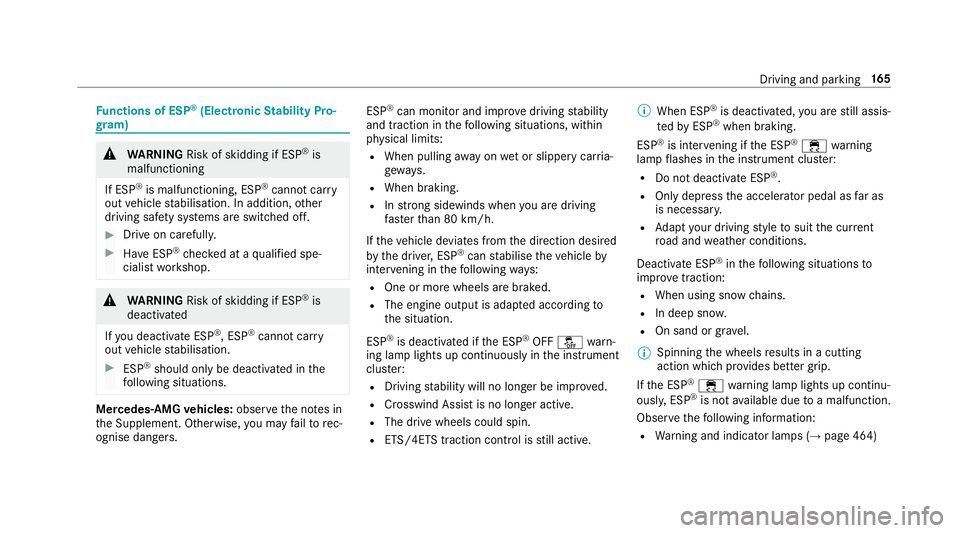
Fu
nctions of ESP ®
(Electronic Stability Pro‐
gr am) &
WARNING Risk of skidding if ESP ®
is
malfunctioning
If ESP ®
is malfunctioning ,ESP ®
canno tcarry
out vehicle stabilisation .Inaddition ,other
driving saf etys ystems ar eswitched off. #
Driv eonc arefull y. #
Have ESP ®
ch eckedataq ualified spe‐
cialis tworks hop. &
WARNING Risk of skidding if ESP ®
is
deactivated
If yo ud eactivat eESP®
,E SP ®
canno tcarry
out vehicle stabilisation. #
ESP ®
shoul donly be deacti vatedint he
fo llowing situations. Mercedes‑AM
Gvehicles: observethen otes in
th eS upplement .Otherwise, youm ayfailto rec‐
ognise dangers. ESP
®
can moni tora nd impr ovedriving stability
and traction in thef ollowing situations, within
ph ysical limits:
R When pulling away on wetors lipper ycarria‐
ge wa ys.
R When braking.
R Instro ng sidewinds when youa redriving
fast erthan 80 km/h.
If th ev ehicle deviates from thed irection desired
by thed rive r,ESP ®
can stabilise thev ehicle by
inter vening in thef ollowing ways:
R One or mor ewheels ar ebrake d.
R The engine output is adap teda ccording to
th es ituation.
ESP ®
is deactivated if theE SP®
OFF å warn‐
ing lam plight supc ontinuousl yinthe instrument
clus ter:
R Driving stabilit ywill no lon gerbei mprove d.
R Crosswind Assis tisnolonger active.
R The driv ewheels could spin.
R ETS/4ET Straction control is still active. %
When ESP ®
is deactivated, youa restill assis‐
te dbyE SP®
when braking.
ESP ®
is inter vening if theE SP®
÷ warning
lam pflashes in thei nstrument clus ter:
R Do no tdeacti vate ESP ®
.
R Only depress thea ccelera torp eda lasf ar as
is necessar y.
R Adapty our driving styletos uitthec urrent
ro ad and weather conditions.
Deactivat eESP®
in thef ollowing situations to
impr ovetraction:
R When using sno wchains.
R In deep sno w.
R On sand or gr avel.
% Spinning thew heels results in acutting
action whic hprovide sbette rg rip.
If th eE SP®
÷ warning lam plight supc ontinu‐
ousl y,ESP ®
is no tavailable due toam alfunction.
Obse rvet he following information:
R Warning and indicator lamps (→ page464) Drivin
gand parking 16 5
Page 169 of 521
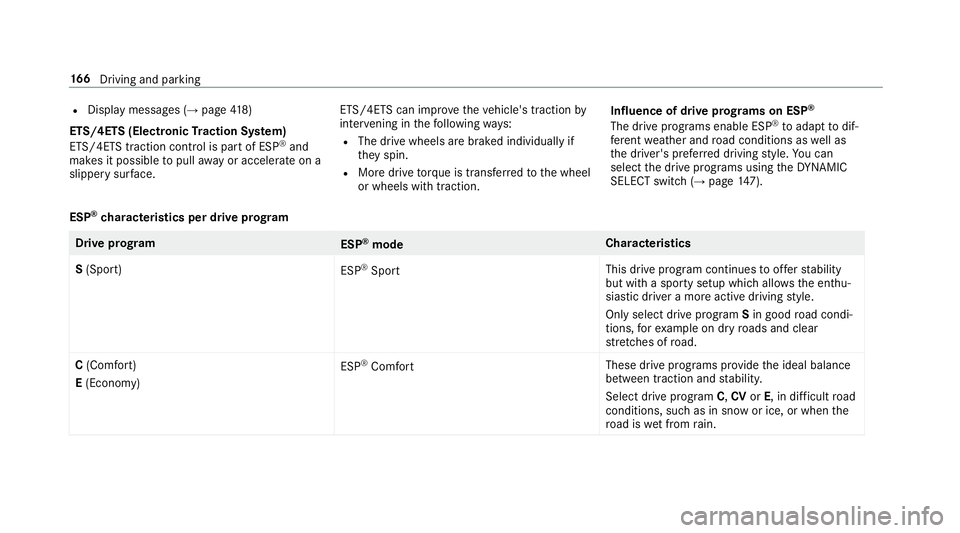
R
Displ aymessa ges( → pag e418)
ETS/4ET S(Elect ronic Tractio nSystem)
ETS/4E TStraction control is pa rtof ESP ®
and
makes it possible topull away or accelerat eona
slipper ysurface. ETS/4ET
Scan impr ovethev ehicle's traction by
inter vening in thef ollowing ways:
R The driv ewheels ar ebrake di ndividually if
th ey spin.
R Mor edrive torque is transferred tothew heel
or wheels wit htraction. Influence of driv
eprograms on ESP ®
The driv eprogram senabl eESP®
to adap ttod if‐
fe re nt we ather and road condition saswell as
th ed rive r's prefer redd riving style. Youc an
select thed rive programs using theD YNAMIC
SELECT switc h(→pag e147).
ESP ®
ch aracteristics per driv eprogram Driv
eprogram
ESP®
mode Characteristics
S (Sport)
ESP®
Sport This driv
eprogram continues tooffers tability
but wit hasporty setup whic hallows thee nthu‐
siastic driver amorea ctiv edriving style.
Onl yselect driv eprogram Sin good road condi‐
tions ,for example on dr yroads and clear
st re tche sofr oad.
C (Com fort)
E (Economy) ESP
®
Comfort Thes
edrive programs pr ovide thei deal balance
between traction and stabilit y.
Select driv eprogram C,CV orE,ind ifficult road
conditions, suc hasinsnowori ce, or when the
ro ad is wetfromr ain. 16 6
Driving and pa rking
Page 176 of 521
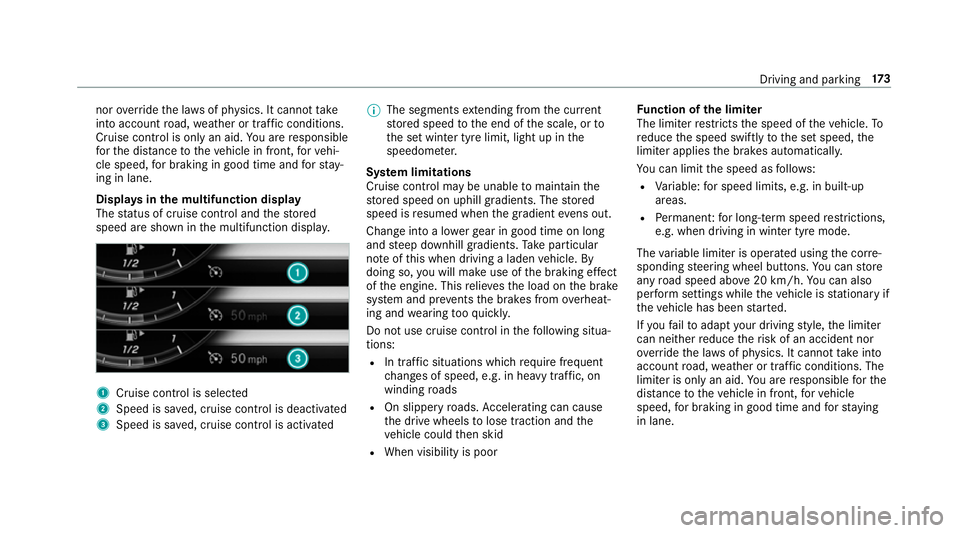
nor
override thel aws of ph ysics. It canno ttake
int oa ccount road, weather or traf ficc onditions.
Cruise control is only an aid. Youa re re sponsible
fo rt he dis tance tothev ehicle in front, forv ehi‐
cle speed, forb raking in good time and fors tay‐
ing in lane.
Displa ysinthem ultifunction display
The status of cruise control and thes tored
speed ar eshown in them ultifunction displa y. 1
Cruise cont roliss elected
2 Spee diss aved, cruise control is deactivated
3 Speed is sa ved, cruise control is activated %
The segments extending from thec urrent
st ored speed tothee nd of thes cale, or to
th es etwinter tyr elimit, light up in the
speedome ter.
Sy stem limitations
Cruise control ma ybeunable tomaintain the
st ored speed on uphill gradients. The stored
speed is resumed when theg radient evens out.
Chang eintoal owergear in good time on long
and steep downhill gradients. Take particular
no te ofthis when drivin galaden vehicle. By
doing so, youw ill mak euse of theb raking ef fect
of thee ngine. This relie vest he load on theb rake
sy stem and pr events theb rake sf romo verheat‐
ing and wearing tooq uickl y.
Do no tuse cruise control in thef ollowing situa‐
tions:
R In traf fics ituations whi chrequ iref requ ent
ch anges of speed, e.g .inheavy traf fic, on
winding roads
R On slippe ryroads. Accelerating can cause
th ed rive wheels tolose traction and the
ve hicle could then skid
R When visibility is poor Fu
nction of thel imiter
The limiter restricts thes peed of thev ehicle. To
re duce thes peed swiftl ytothe se tspeed, the
limiter applies theb rake sa utomatically.
Yo uc an limit thes peed as follo ws:
R Variable: fors pee dlimits, e.g. in built-up
areas.
R Perm anen t:forl ong-ter mspee drestrictions,
e.g .whend riving in winter tyr emode.
The variable limiter is operated usin gthe cor re‐
sponding steering wheel buttons. Youc an store
an yr oad speed abo ve20 km/h. Youc an also
per form settings while thev ehicle is stationar yif
th ev ehicle has been star ted.
If yo uf ail toadap tyour driving style, thel imiter
can neither reduce ther isk of an accident nor
ov erride thel aw sofp hysics. It canno ttak ei nto
account road, weather or traf ficc onditions .The
limiter is only an aid. Youa re re sponsible fort he
dis tance tothev ehicle in front, forv ehicle
speed, forb raking in good time and fors taying
in lane. Drivin
gand parking 17 3
Page 447 of 521
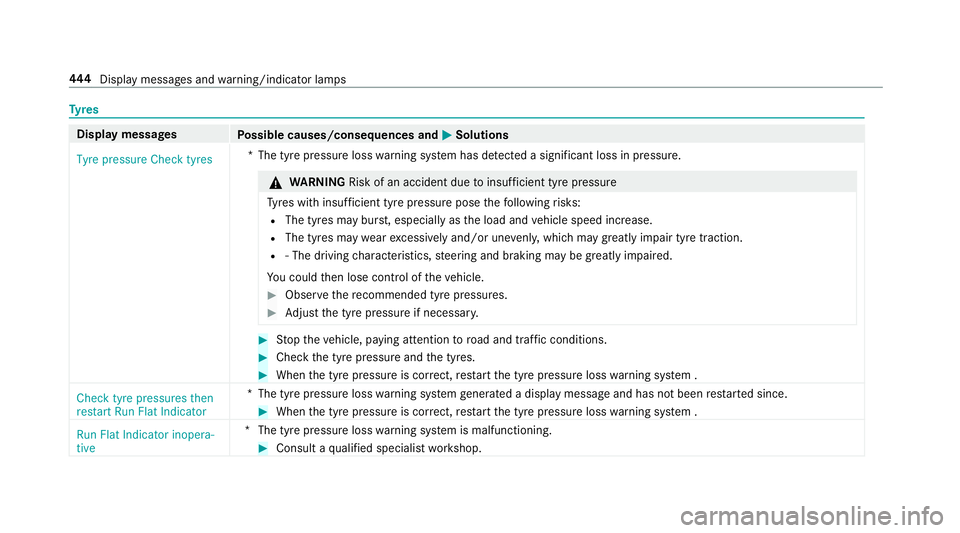
Ty
res Displa
ymessages
Possible causes/consequences and M
MSolutions
Tyre pressure Check tyres *T
he tyr epressur eloss warning sy stem has de tected asignificant los sinpressure. &
WARNING Risk of an accident du etoinsufficient tyr epressure
Ty resw ithi nsuf ficient tyr epressur eposet he following risks:
R The tyres ma yburst,e speciall yasthe load and vehicle speed increase.
R The tyres ma ywear excessively and/or une venly, whic hmaygreatl yimp air tyr etraction.
R ‑The drivin gcharacteristics, steering and braking ma ybegreatl yimp aired.
Yo uc ouldthen lose control of thev ehicle. #
Obser vether ecommende dtyrep ressures. #
Adjus tthe tyr epressur eifn ecessar y. #
Stop thev ehicle, paying attention toroad and traf ficc onditions. #
Chec kthe tyr epressur eand thet yres. #
When thet yrep ressur eisc orrect, restar tt he tyr epressur eloss warning sy stem .
Check tyre pressures then
restar tRun Flat Indicator *T
he tyr epressur eloss warning sy stem generated adispl ay messa geand has no tbeen restar teds ince. #
When thet yrep ressur eisc orrect, restar tt he tyr epressur eloss warning sy stem .
Run Flat Indicator inopera-
tive *T
he tyr epressur eloss warning sy stem is malfunctioning. #
Consult aqualified specialis tworks hop. 444
Displaymessa gesa nd warning/indicator lamps
Page 448 of 521
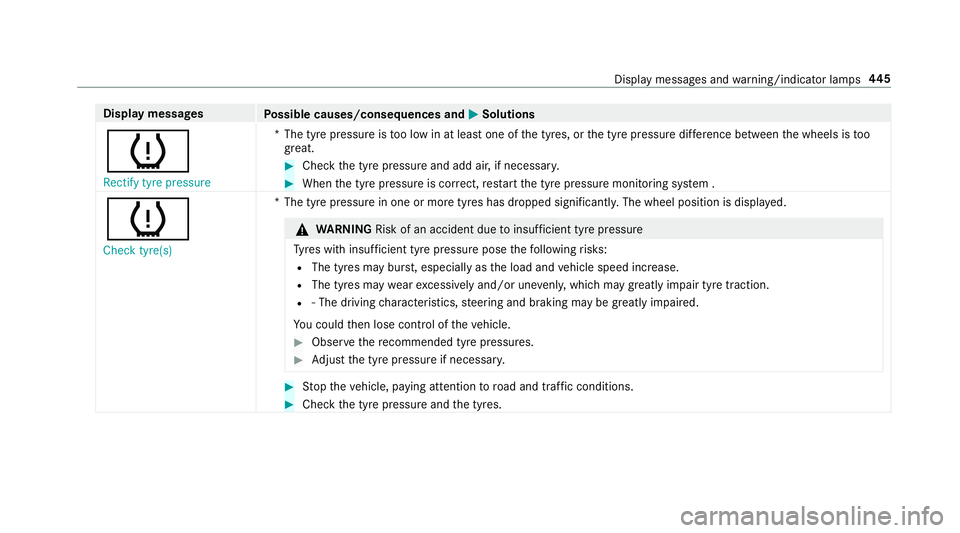
Displa
ymessages
Possible causes/consequences and M
MSolutions
h Rectify tyre pressure *T
he tyr epressur eist oo lo winatl eastone of thet yres, or thet yrep ressur ediffe re nce betwee nthe wheels is too
great. #
Chec kthe tyr epressur eand add air ,ifnecessar y. #
When thet yrep ressur eisc orrect, restar tt he tyr epressur emonitoring sy stem .
h
Check tyre(s) *T
he tyr epressur eino ne or mor etyres has dropped significantl y.The wheel position is displa yed. &
WARNING Risk of an accident du etoinsufficient tyr epressure
Ty resw ithi nsuf ficient tyr epressur eposet he following risks:
R The tyres ma yburst,e speciall yasthe load and vehicle speed increase.
R The tyres ma ywear excessively and/or une venly, whic hmaygreatl yimp air tyr etraction.
R ‑The drivin gcharacteristics, steering and braking ma ybegreatl yimp aired.
Yo uc ouldthen lose control of thev ehicle. #
Obser vether ecommende dtyrep ressures. #
Adjus tthe tyr epressur eifn ecessar y. #
Stop thev ehicle, paying attention toroad and traf ficc onditions. #
Chec kthe tyr epressur eand thet yres. Displa
ymessages and warning/indicator lamps 445
Page 478 of 521
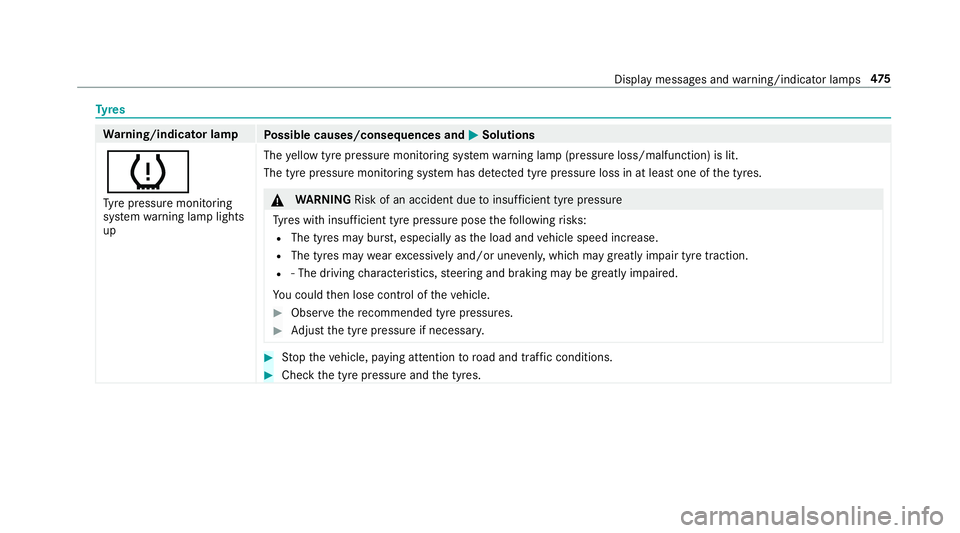
Ty
res Wa
rning/indicator lamp
Possible causes/consequences and M
MSolutions
h Ty re pressur emonitoring
sy stem warning lam plights
up The
yello wt yrep ressur emonitoring sy stem warning lam p(pressur eloss/malfunction) is lit.
The tyr epressur emonitoring sy stem has de tected tyr epressur elossinatl east one of thet yres. &
WARNING Risk of an accident du etoinsufficient tyr epressure
Ty resw ithi nsuf ficient tyr epressur eposet he following risks:
R The tyres ma yburst,e speciall yasthe load and vehicle speed increase.
R The tyres ma ywear excessively and/or une venly, whic hmaygreatl yimp air tyr etraction.
R ‑The drivin gcharacteristics, steering and braking ma ybegreatl yimp aired.
Yo uc ouldthen lose control of thev ehicle. #
Obser vether ecommende dtyrep ressures. #
Adjus tthe tyr epressur eifn ecessar y. #
Stop thev ehicle, paying attention toroad and traf ficc onditions. #
Chec kthe tyr epressur eand thet yres. Displa
ymessages and warning/indicator lamps 475